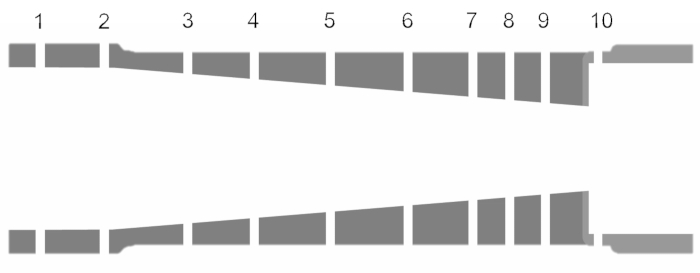喷嘴分析:沿聚合和融合分流喷嘴的马赫数和压力的变化
Overview
资料来源:北卡罗来纳州立大学机械和航空航天工程系,北卡罗来纳州罗利市,史雷亚斯·纳西普尔
喷嘴是一种通常用来加速或减速流的装置,其横截面各不相同。喷嘴广泛应用于航空航天推进系统。在火箭中,从腔室中喷出的推进剂通过喷嘴加速,形成推动系统的反应力。在喷气发动机中,喷嘴用于将能量从高压源转化为排气的动能,从而产生推力。喷嘴上的异位模型足以进行一阶分析,因为喷嘴中的流量非常快(因此与第一次近似极值极差),摩擦损失很小(因为流量几乎是一维的,具有有利的压力梯度,除非冲击波形成且喷嘴相对较短)。
在本实验中,两种类型的喷嘴安装在喷嘴测试装置上,并使用压缩空气源创建压力流。喷嘴运行不同的背压设置,以分析喷嘴中不同流量条件下的内部流量,识别各种流量机制,并将数据与理论预测进行比较。
Procedure
在本演示中,使用了喷嘴测试装置,该测试装置由压缩空气源组成,该空气源通过被测试的喷嘴输送高压空气,如图5所示。流量压力范围为 0 - 120 psi,使用机械阀进行控制。当使用外部传感器测量压力时,喷嘴中的质量流速由放置在喷嘴测试台排气前的一对旋转计进行测量。

图5.喷嘴测试台。请点击此处查看此图的较大版本。
1. 测量收敛和汇合分散喷嘴中的轴向压力
- 将收敛喷嘴安装在喷嘴测试台的中心,如图5所示。具有压水龙头标签的收敛喷嘴的二维部分如图.css-f1q1l5{display:-webkit-box;display:-webkit-flex;display:-ms-flexbox;display:flex;-webkit-align-items:flex-end;-webkit-box-align:flex-end;-ms-flex-align:flex-end;align-items:flex-end;background-image:linear-gradient(180deg, rgba(255, 255, 255, 0) 0%, rgba(255, 255, 255, 0.8) 40%, rgba(255, 255, 255, 1) 100%);width:100%;height:100%;position:absolute;bottom:0px;left:0px;font-size:var(--chakra-fontSizes-lg);color:#676B82;}
Results
跳至...
此集合中的视频:

Now Playing
喷嘴分析:沿聚合和融合分流喷嘴的马赫数和压力的变化
Aeronautical Engineering
38.0K Views

模型飞机的空气动力学性能:DC-6B
Aeronautical Engineering
8.3K Views

推进器特性:音高、直径和叶片数在性能上的变化
Aeronautical Engineering
26.5K Views

机翼行为:克拉克Y-14翼上的压力分布
Aeronautical Engineering
21.2K Views

Clark Y-14 翼性能:高提升设备的部署(片和板条)
Aeronautical Engineering
13.4K Views

湍流球法:评估风洞流量质量
Aeronautical Engineering
8.7K Views

交叉圆柱流:测量压力分布和估计阻力系数
Aeronautical Engineering
16.2K Views

施利伦成像:一种可视化超音速流特性的技术
Aeronautical Engineering
11.7K Views

水隧道中的流量可视化:在三角洲翼上观察前沿涡流
Aeronautical Engineering
8.2K Views

表面染料流可视化:观察超音速流中条纹模式的定性方法
Aeronautical Engineering
4.9K Views

皮托静态管:测量气流速度的设备
Aeronautical Engineering
49.2K Views

恒温测量:研究湍流边界层流的工具
Aeronautical Engineering
7.3K Views

压力传感器:使用皮托静态管进行校准
Aeronautical Engineering
8.5K Views

实时飞行控制:嵌入式传感器校准和数据采集
Aeronautical Engineering
10.3K Views

多直升机空气动力学:六轴飞行器上的特征推力
Aeronautical Engineering
9.2K Views
版权所属 © 2025 MyJoVE 公司版权所有,本公司不涉及任何医疗业务和医疗服务。

